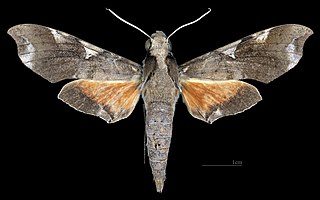
Paratrea is a monotypic moth genus in the family Sphingidae erected by Augustus Radcliffe Grote in 1903. Its single species, Paratrea plebeja, the plebeian sphinx moth, was first described by Johan Christian Fabricius in 1777. It is found in the eastern part of the United States as far west as Nebraska, Kansas, Oklahoma and eastern Texas.

Xylophanes tersa, the tersa sphinx, is a moth of the family Sphingidae. The species was first described by Carl Linnaeus in 1771. It is found from the United States, through Mexico, the West Indies and Central America and into parts of South America. An occasional stray can be found as far north as Canada.

Polyptychus affinis is a moth of the family Sphingidae first described by Walter Rothschild and Karl Jordan in 1903. It is known at elevations up to 6,000 feet (1,800 m) in forests from Sierra Leone to the Congo, Uganda and western Kenya.

The fabulous green sphinx moth or fabulous green sphinx of Kauai is a species of moth in the family Sphingidae. It is monotypic within the genus Tinostoma. It is endemic to the Hawaiian Islands and was thought to be extinct until it was rediscovered in 1998. The genus was erected by Walter Rothschild and Karl Jordan in 1903 and the species was first described by Edward Meyrick in 1899.

Degmaptera is a genus of moths in the family Sphingidae. The genus was erected by George Hampson in 1896.

Amphimoea is a monotypic moth genus in the family Sphingidae erected by Walter Rothschild and Karl Jordan in 1903. Its only species, Amphimoea walkeri, the Darwin hawkmoth, described by Jean Baptiste Boisduval in 1875, is found from Mexico south to Argentina.

Acosmerycoides is a monotypic moth genus in the family Sphingidae described by Rudolf Mell in 1922. Its only species, Acosmerycoides harterti or Hartert's hawkmoth, was described by Walter Rothschild in 1895.

Hyles nervosa, the Ladakh hawkmoth, is a moth of the family Sphingidae. The species was first described by Walter Rothschild and Karl Jordan in 1903. It is found in eastern Afghanistan, northern and western India, northern Pakistan and the extreme west of the Xizang province and Tibet.

Acosmeryx anceus is a moth of the family Sphingidae. It was described by Caspar Stoll in 1781, and it is known from India, New Guinea, and Queensland, Australia.

Ampelophaga khasiana, the scarce vine hawkmoth, is a moth of the family Sphingidae. It was described by Walter Rothschild in 1895. It is found from Nepal, Sikkim in north-eastern India and to central China.

Pseudoangonyx is a monotypic moth genus in the family Sphingidae described by Ulf Eitschberger in 2010. Its only species, Pseudoangonyx excellens, described by Walter Rothschild in 1911, is known from Aru, Papua New Guinea and northern Queensland.

Antinephele lunulata is a moth of the family Sphingidae. It was described by Rothschild and Jordan in 1903, and is known from forests and wooded habitats from Sierra Leone to Cameroon, the Democratic Republic of the Congo, Zambia, Zimbabwe and Tanzania, as well as Madagascar.

Callionima acuta is a species of moth in the family Sphingidae. It was originally described by Walter Rothschild and Karl Jordan as Hemeroplanes acuta, in 1910.

Hemaris alaiana, the Alai bee hawkmoth, is a moth of the family Sphingidae. The species was first described by Walter Rothschild and Karl Jordan in 1903. It is known from the Alayskiy Khrebet, Tian Shan, Dzungarian Alatau, Saur and Altai mountains, from Tajikistan and eastern Kazakhstan to western Mongolia. The habitat consists of montane meadows and woodland glades rich in flowers, generally from 1,400 to 2,200 meters altitude.

Eumorpha adamsi is a species of moth in the family Sphingidae. It was described by Walter Rothschild and Karl Jordan, in 1903, and is known from Venezuela, Brazil, Bolivia and Paraguay but is probably present throughout most of South America.

Euryglottis albostigmata is a moth of the family Sphingidae first described by Walter Rothschild in 1895.

Degmaptera mirabilis, the variegated hawkmoth, is a species of moth of the family Sphingidae. It is known from Nepal, north-eastern India, northern Thailand, Anhui in China and Taiwan. The habitat consists of high altitude evergreen oak forests.

Degmaptera olivacea is a species of moth of the family Sphingidae first described by Walter Rothschild in 1894. It is known from Peninsular Malaysia and Borneo.

Marumba juvencus is a species of moth of the family Sphingidae first described by Walter Rothschild and Karl Jordan in 1912.

Clanis stenosema is a species of moth of the family Sphingidae first described by Rothschild and Jordan in 1907. It is known from Nias, Sumatra, Java, Borneo and the Philippines.




















